Forcing Bolts
EXPERT OPINIONS: Natural Fruiting
“Logs will naturally fruit after periods of heavy rains or wide temperature fluctuations. In general, cold weather strains have a greater tendency to fruit naturally compared to warm weather and all-weather stains. Your choice to either fruit the log naturally or to shock/ force the log under a rotation depends on your goals.
“Natural fruiting is certainly less labor intensive but shiitake production per log is much lower and lacks control over when the logs fruit. This can lead to shortages especially during the warm summer months, and surpluses during cool or especially wet periods. Be aware that if fruiting begins during a rainy period, the mushrooms become fairly water logged, increase their weight, and lose quality.”
- Ken Mudge, Cornell University
EXPERT TIPS: Start Shocking
“I like to start my forcing regime after logs have produced their first natural flush.”
Steve Sierigk, Hawk Meadow Farm
“I often try a smaller test soak to see where WR logs are at in terms of response and will often try a dozen logs ... if no response it was just a good soaking. Last year I tried a mid-May test soak with my WR logs ... no response ... but the following week worked and from then on I started my forcing cycles. This year is definitely ahead of last year.
Steve Sierigk, Hawk Meadow Farm
Forcing Bolts
Forcing is a matter of speeding up Mother Nature. Any log that has completed the spawn run and is well colonized with the shiitake fungal mycelium will fruit spontaneously under the right conditions albeit sporadically (unpredictably). But that may not satisfy a grower who needs a bunch of mushrooms within a short period of time (called a flush) to take to market, or for an upcoming picnic or dinner party. Fortunately, shiitake is one of the few mushrooms that can be made to “fruit” on demand. That is done through a process called forcing triggers the mycelium to produce fruiting bodies (mushrooms) predictably, within a short period of time. “Shocking” is how it’s done. Shocking involves soaking logs in cold water for an extended period of time (12 to 24 hours) to induce fruiting. By shocking your logs on a schedule, you can generate a steady supply of shiitake mushrooms on a predictable rotation. See comments on page 31.
Logs should be stacked in the laying yard so they are easily identified in order to establish a schedule for shocking and harvesting. A shocking schedule should be developed which specifies how many pounds of mushrooms are needed and when they are needed (see example on page 32).
Based on this you can plan how many logs to force with each scheduled shocking, the number of times each log will be forced per season, when logs will be forced, how logs will move through the laying yard, when mushrooms are needed, when mushrooms are predicted to be available, and finally, when logs will be retired at the end of their lifetime.
When to Start Shocking
When to start shocking depends on the strain and log species. One option is to observe the mycelium growth (white discoloration) on the end of the bolt (see sidebar on page 23 for more information). When mycelium is visible on most of the bolt end, the bolt should be ready to fruit. Some logs might not have white mycelium visible on the log end but might still be ready to fruit. Generally, smaller diameter logs and warm weather spawn run are ready to be shocked sooner than larger logs and cold weather strains. Also, night- time temperatures should average above 50 degrees Fahrenheit before logs are shocked.
Most growers end up shocking after about a year. But you may find the logs aren’t ready yet or that the first flush is small. The size of the flush depends on how much spawn was placed in the log during the inoculation phase, how moist the logs were kept, and how much competitive fungi exist in the log. If your first flush is small, don’t despair -- try again about two months later.
RESEARCH: Spawn Run Length
Those who waited longer prior to shocking were rewarded with significantly greater shiitake production. Although you can shock after 12 months, it might be advisable to wait a bit longer - perhaps 14 to 16 months.
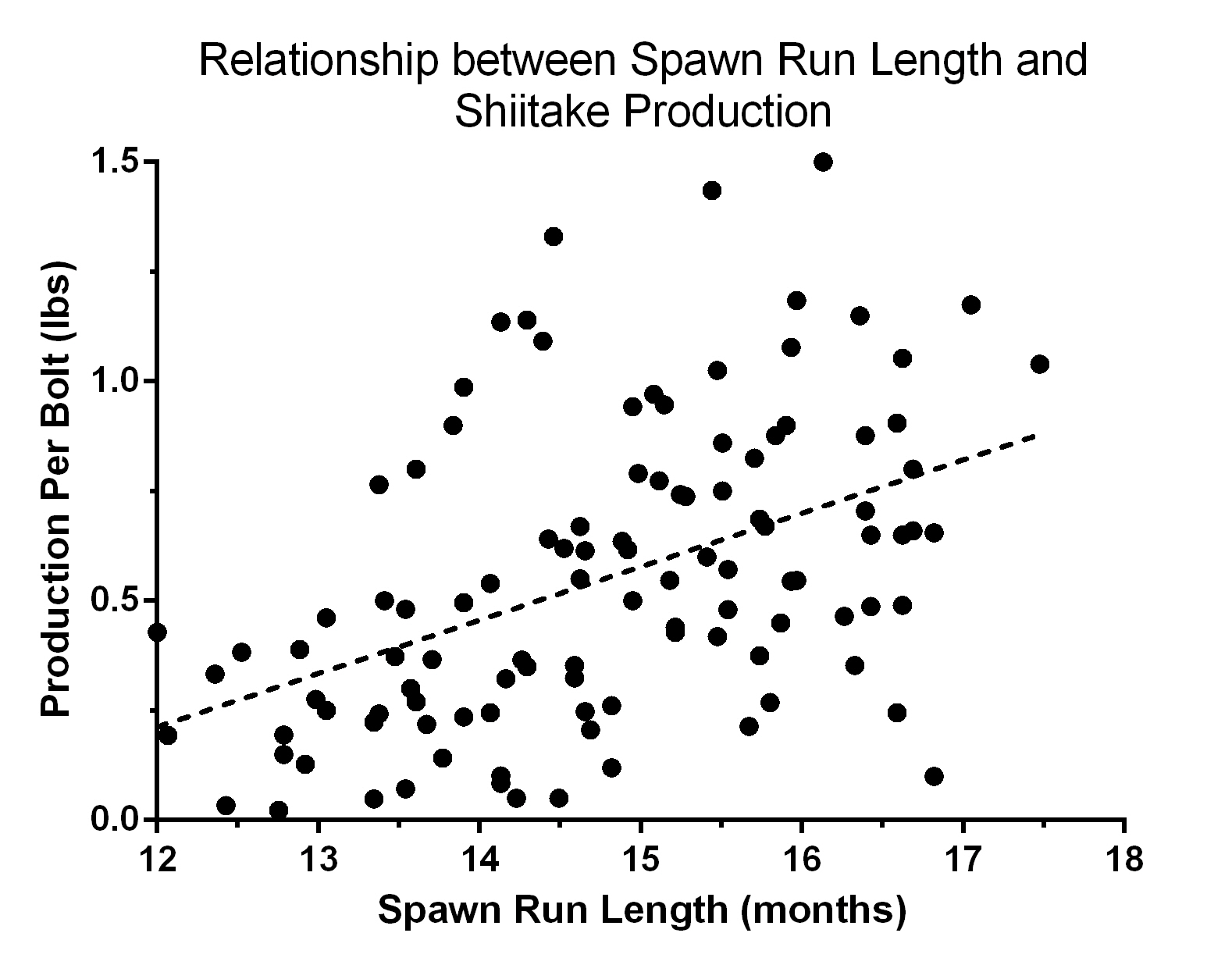
EXPERT TIPS & TRICKS: Maximizing Year-round Harvests
Described in detail below is the strategy used by Steve Sierigk of Hawk Meadow Farm for maximizing shiitake production through a combination of (1) season extension using cold weather shiitake strains and (2) aggressive forcing schedule during the warmer months wherein seven groups of logs are soaked one week apart.
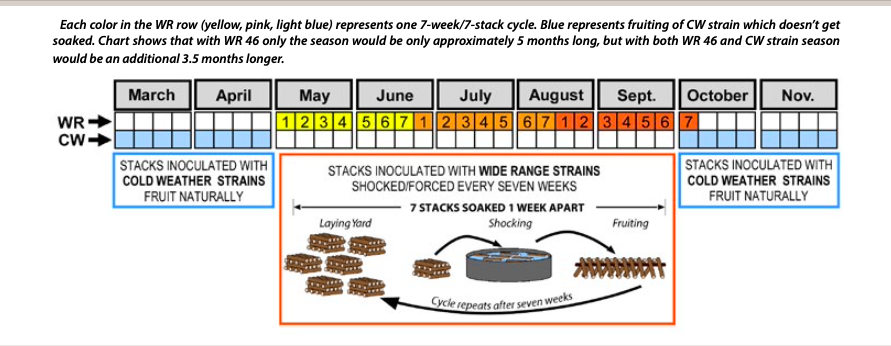
SEASON EXTENSION
During the cooler months (March, April, October and November) logs inoculated with cold weather strains are allowed to fruit naturally without being soaked.
Cold weather strains fruit naturally during the transition times from spring to summer and summer to fall. Northeast-based growers can inoculate some bolts (particularly large, heavy bolts) with enough cold weather strain to supply late spring and fall markets. These logs (displayed in the diagram above in blue) are allowed to fruit naturally during March and April, and October through mid-November. This enables one to obtain mushrooms and additional 3.5 months.
AGGRESSIVE FORCING SCHEDULE
During the warmer months (May, June, July, and August), groups of logs are forced by soaking them every seven weeks. In this example, the production logs that are to be fruited, are divided into 7 groups. The first group is forced in week 1, and then set out to rest. The same for the 2nd, 3rd up to the 7th group successively at one week intervals. By the time the 7th group has been forced on week 7, the first group has rested for 7 weeks and is ready to be forced for the 2nd time on week 8, follow by the remaining groups at 1 week intervals. This cycle may be repeated two or three times depending on the length of the production season.
The length of the forcing season depends on the weather; when using a wide range spawn, we recommend beginning once the temperatures reach 70. Depending on your region, you’ll likely have an 18- to 20-week time period. Many stacks will be forced 3 times in a season while some stacks may be forced twice.
Shiitake mycelium requires 40 days of carbohydrate metabolism to support the next flush of mushrooms after the last flush, although this time period may be flexible under different temperature and moisture regimes. Although a grower could push the forcing stacks to be flushed every 6 weeks, we recommend adding the extra week just to be on the safe side that the logs will really be ready.
OTHER FACTORS
You may also want to consider other factors like strains, and log ages when laying out your yard. Bolt stacks are often dynamic entities; consider culling out unproductive logs while adding newcomers to the forcing group. Managing the laying yard in a way that allows growers to rotate logs will allow them to consistently provide shiitake throughout the growing season to their prospective markets. Knowing when logs were inoculated, when they were shocked, and when they were harvested is extremely important to maintain consistency.
EXPERT TIPS: Chlorinated Water
Some growers may be concerned about the chlorine in their water system and its impact on shiitake spawn; most have found that city water does not affect production. However, it is possible to off-gas the water used for shocking for 24 hours to reduce any risk by simply leaving the water uncovered for 24 hours.
EXPERT OPINION: Warm Weather Forcing
“In general I force logs at all times of the year for 24 hours ... but I have read that when the weather is warmer you need shorter soaks to trigger the forcing response while in the spring and fall it takes a longer time period to trigger the same response.”
- Steve Sierigk, Hawk Meadow Farm
EXPERT OPINION: Twelve Hour Soak?
“Essentially, the greater quantity of water absorbed the better, during your forcing soak. With that being said, we were unable to see statistical differences between 12- and 24-hour soaks of the same tree species. So what does all this really mean?
“You could probably get away with a 12-hour soak, if you are using logs that take up moisture very easily, such as Carpinus sp., whereas a Red Oak or Sugar Maple, which takes water up at a slower rate than Carpinus, may need more time in the bath tub. When looking at yields, one very important predictor was total water absorption.”
-Bryan Sobel, Cornell University
EXPERT OPINION: Forcing After a Natural Flush
“If only a few mushrooms have popped out naturally, I generally will force these logs after I pick the mushrooms. Instead of a full 24-hour soak you can just do a shorter soak to keep the mycelium humming (4 to 6 hours) ... this should be enough to trigger a flush.
“If it is a significant number of mushrooms (like more than let’s say 6 to 10) I somewhat consider that a flush and wait about 7 to 8 weeks to force again.“
- Steve Sierigk, Hawk Meadow Farm
EXPERT OPINION: How Often to Shock
“I suggest trying to fruit your logs as often as possible from an economic standpoint, within the understood guidelines of the spawn regeneration/resting period. If your logs are still producing and a market still exists, you’d be maximizing your production. While the overall years of your logs may possibly diminish, you’re reducing the risk of external failures over time such as drought, pests, other fungi, etc. It’s up to the farmer to be very efficient with inoc- ulation and maintain consistent shiitake production a goal to overcome the high cost of labor and sustain operations.”
- Nick Laskovski, Dana Forest Farm
EXPERT OPINION: Culling Logs
“We cull logs based on what year they were inoculated and cull a whole year’s worth of logs at a time after the 3rd fruiting year. Unlike some growers, we do not mix new logs in with older logs. We keep each crib stack of 20-25 logs together as a group from inoculation till they are culled. We want to observe & record harvests per year and per strain to track productivity and monitor longevity. It’s hard to give up on logs, so we put the culled logs in an area out of the way for their 4th year and get a few mushrooms from them, but the following year they are used for our festival bonfires. Another thing we do differently is to keep the logs in crib stack for the incubation year and then set them in A-frame formation the next spring and do not ever put them back in crib stack. So far, room to do this has not been an issue and this method saves labor moving logs after fruiting.“
- Steve and Julie Rockcastle, Green Heron Growers
How to Shock
Submerge the logs in water for 24 hours. In general, logs left in the water for a longer or shorter amount of time will not reach their production potential. However, many growers may choose to vary the duration of the soaking based on the air temperature, log species and age of log. (See the side bars for more information.)
When you remove the logs from the water, stack them in an A-frame (conducive to the upcoming harvest). A high A-frame consists of logs leaning upright on one or two sides against a supporting beam, such as a cut sapling lashed horizontally onto two trees or a taut wire. This stacking method works well for the fruiting and harvest stages. Logs are well aerated, mushrooms are easily visible, and picking is easy, as there is maximum access to each log. Because logs stacked in A-frames take up a lot of space in a laying yard, they are usually not left on the A-frame for any other part of the process; this is especially true for a forced production model.
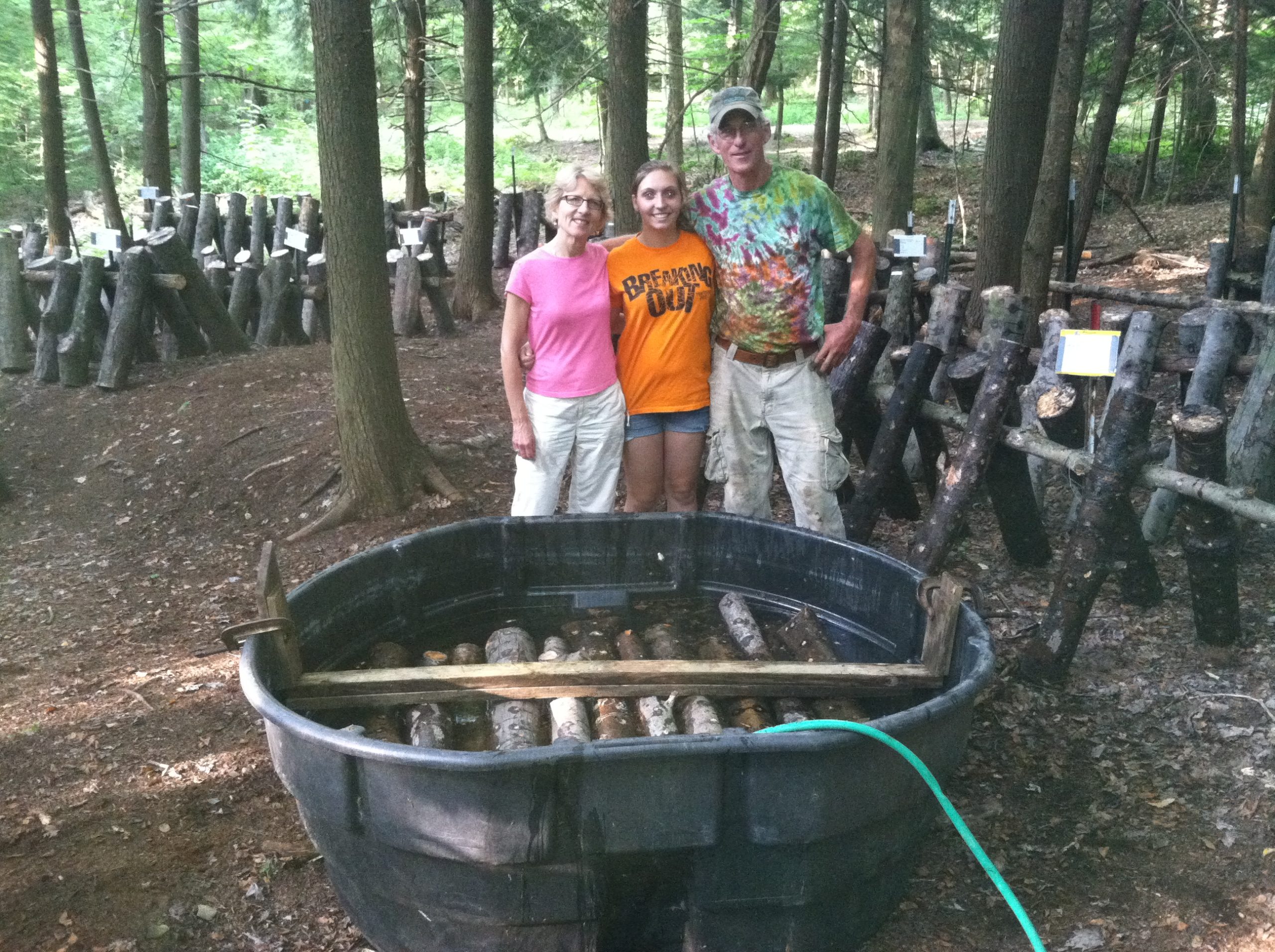

Protect Mushrooms during Growth Phase
In 3 to 5 days, the log will begin pinning; Look for bumps about the size of a pencil eraser. At this point, consider protecting the mushrooms from high winds and cold weather, which can dry the mushrooms and inhibit their growth. Mushrooms exposed to freezing conditions during growth may either stop growing or develop an unfavorable texture.
Also try to protect budding mushrooms against rain storms, particularly 2 to 3 days before picking. Rain causes mushrooms to become soggy and waterlogged. Wet mushrooms are significantly less valuable; many growers discount the price by 20 to 25 percent, if they sell them at all.
Professional growers recommend covering your logs with fruiting blankets, agricultural cloth, or tarps to keep the mushrooms from freezing and getting more wet. Different types of cover may also reduce the potential for insects and other pests to damage the newly fruited shiitake mushrooms.
Where to Shock
Place the logs in the coldest water available — a 100 gallon cattle trough or big tub works best. Because temperature adjustment is not practical, we recommend filling the tank from a fast moving stream or keeping the tank out of the sun. Rainwater collection is also a possibility. Ponds work well, though they may make log retrieval difficult.
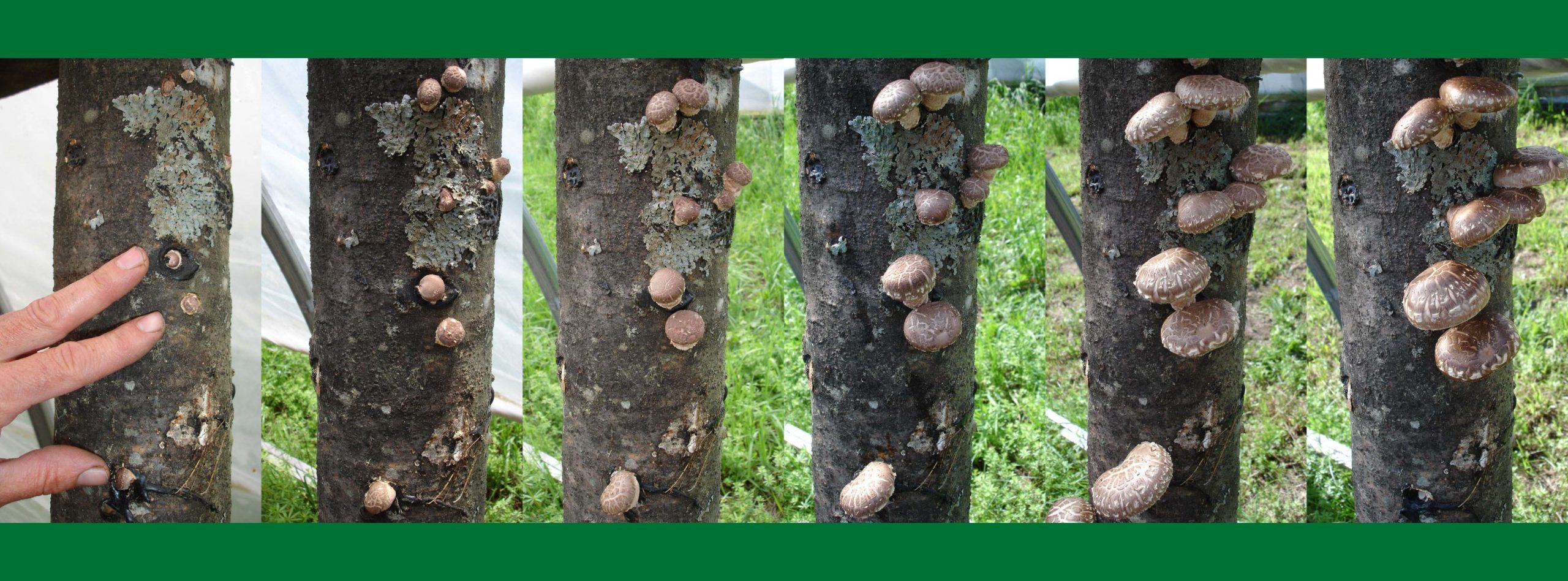
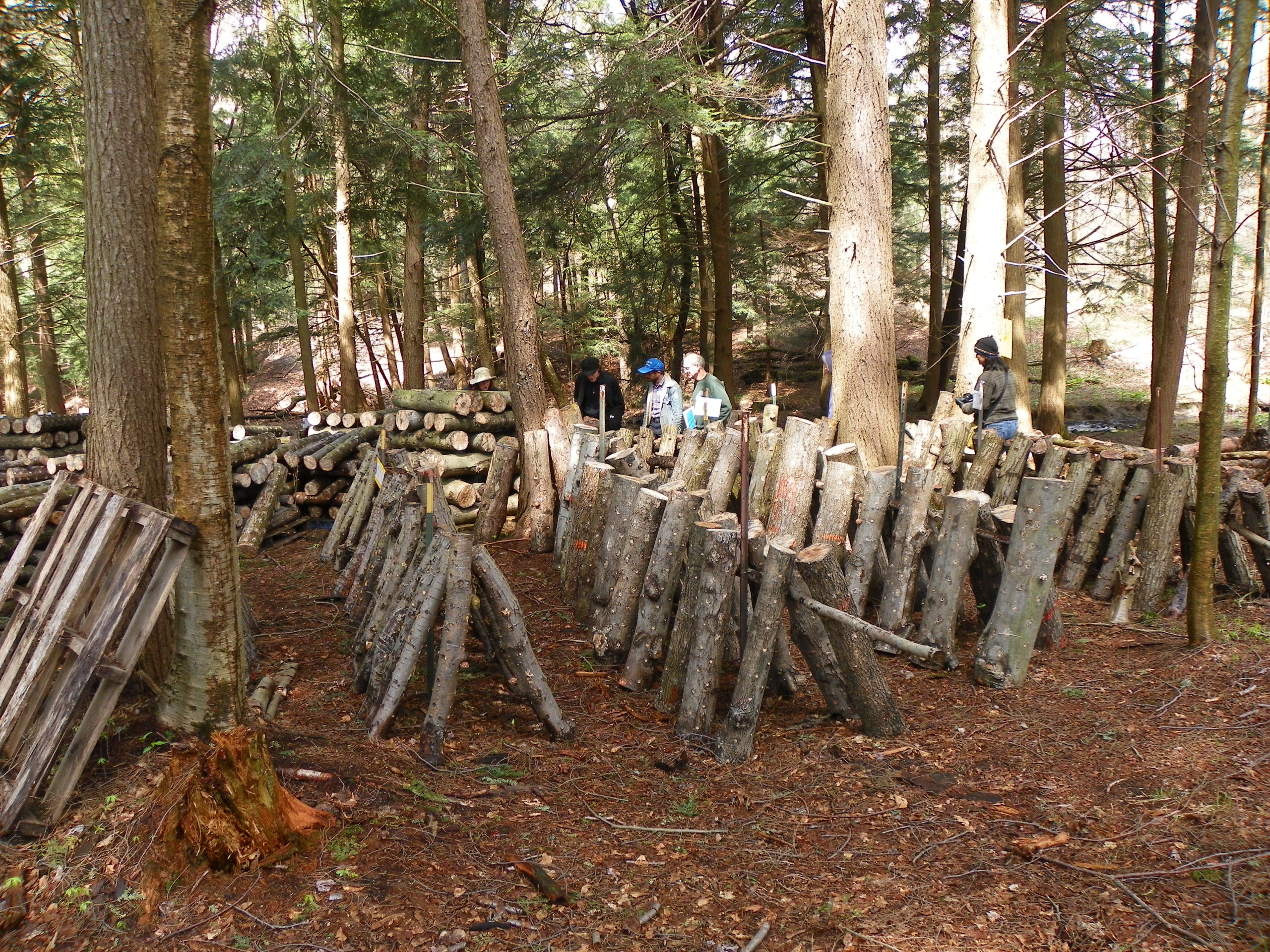
How Often to Shock Bolts
After fruiting, logs need to be rested for 6 to 8 weeks before being forced again. The more often the logs are shocked, the shorter their lifetime is likely to be. Experienced growers recom- mend trying to fruit your logs as often as possible (two to three times a year) for the following reasons:
It keeps the logs well hydrated, therefore there is little need for maintenance soaks in between forcing.
- It minimizes the probability of resting stacks producing mushrooms spontaneously (which are hard to pick).
- It optimizes the ultimate yield of shiitakes from logs by reducing the probability that external factors (drought, pests, competitive fungi) negatively impact production.
- It imposes a sense of order to stacks of logs so that they can be easily managed each week.
For more information regarding how often to shock logs, see the expert tip on page 31.
Culling Unproductive Logs
Excerpt by Steve Sierigk, Hawk Meadow Farm
When you are first starting to build the size of your shiitake yard, and your inoculated logs are still young and productive, it is not always easy to think about culling out unproductive logs. It is not easy to give up on logs that have served you well, but there comes a time when your labor in moving logs around is not justified in log productivity.
Create a criteria outlining when you might start to pull logs out of your active forcing cycles. You will notice at some point that forced logs start to produce shiitakes sparsely and of much smaller size: it may be time to give up on these logs. Logs will also have a spent look; losing bark, losing weight, starting to get more competitors and starting to get punky. For instance if you introduce 100 new logs into your yard each year and force all logs twice a year, by year four you will expect to see signs of your first log burnout.
There are no hard rules for how to deal with these logs. One option is to leave them in a transition area for one year with no active management; expect to pick occasional mushrooms off some of these logs. Experienced growers also recommend using them around garden borders (you may even pick occasional shiitakes from these too). Some growers also burn spent logs in woodstoves as a heat source.
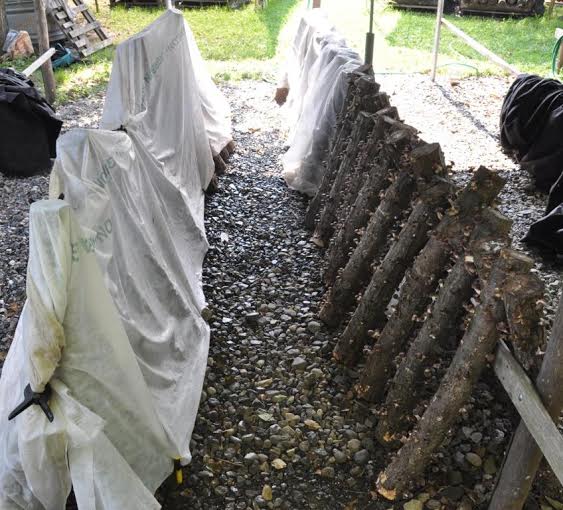
EXPERT TIPS & TRICKS: Many Uses of Agricultural Cloth and Tarps
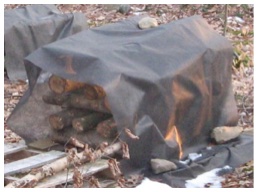
WIND AND COLD PROTECTION
“Agricultural Cloth moderates the effects of weather on developing mushrooms. Developing mushroom pins can desiccate even in protected sites from the effects of sun and wind; agricultural cloth draped over pinning logs can protect mushrooms from sun and wind without Affecting mushroom quality. Be aware, however, if it is raining that ag cloth offers no protection from getting soggy mushrooms so you might want to use plastic tarps to cover logs in these situations.
When it is cold, I generally cover logs with a fruiting blanket or tarp in the late afternoon and take them off again after it has warmed up a bit. I will use agricultural cloth (row cover material) during a forcing if there are steady winds as wind can especially dry out beginning pins. I don’t mind keeping the ag cloth on for extended periods during the forcing because it lets light through and shiitake quality never seems to have changed when I left ag cloth on for entire length of forcing.”
-Steve Sierigk, Hawk Meadow Farm
“Growing mushrooms outdoors on logs offers many challenges, but we growers have many tools to help stack the odds in our favor. I came upon using ag cloth early on in growing shiitakes and it has made our crops a lot more able to withstand many variables, especially weather. I recommend purchasing a high-quality ag cloth as light-weight ones don’t hold up well and tear easily on logs; Agribon, available through Johnny’s, is quite reasonably priced.“
- Steve Sierigk, Hawk Meadow Farm
RAIN PROTECTION
“Although tarps are a great tool they can cause problems too. I don’t like to use them more than I have to ... and have now generally favored the ag cloth if it is too hot or windy ... and only bring out the plastic tarps to keep off rain. I have also observed that keeping tarps on too long favors other shiitake competitors.
I will use plastic tarps (I prefer clear plastic so I can see what is happening) when I see the threat of rain, especially being vigilant the 2 days before picking. Wet mushrooms are a bummer ... and I usually discount their price by 20 to 25 percent if I sell them at all. I don’t like to leave plastic on longer than necessary because I have an intuitive feeling that these mushrooms don’t develop as good a taste or color when under a tarp their whole time ... especially if tarp is very opaque ... they also seem to get on the leggy side and seem lighter in color to me. “
- Steve Sierigk, Hawk Meadow Farm
“White plastic is what we had amongst our farm supplies, so we started using it. First to cover fresh cut logs before inoculation and then to protect fruiting logs from rain. We cover logs only after they’ve been soaked and the mushrooms are about half grown. White plastic doesn’t let much light in, so we don’t get heat built up around the mushrooms. We have yet to try Agribon”
- Steve and Julie Rockcastle, Green Heron Growers
“Being able to cover your mushrooms prior to a heavy rain can help save a mushroom crop from becoming too soggy. Clear tarps tend to create a greenhouse-style effect on mushroom caps and should be used with caution based on direct sunlight and outdoor temperatures. When used, watch to make sure the logs/mushrooms are not overheating beneath the tarp.”
- Nick Laskovski, Dana Forest Farm
“I’ve been using nursery grade shade cloth 80 percent and it’s working wonderfully; tarps seem overly oppressive, and the shade cloth does well in sheltering from rain.”
- Steve Gabriel, Wellspring Forest Farm, Mecklenburg NY
EXPERT TIPS & TRICKS: Many Uses of Agricultural Cloth and Tarps
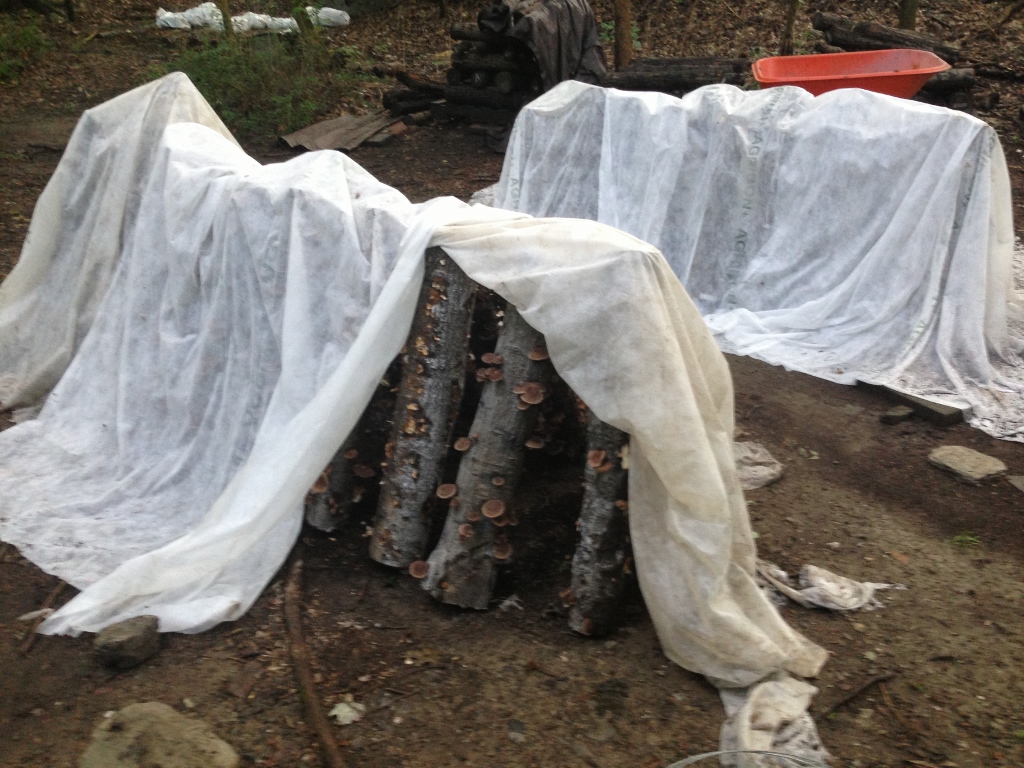
SEASON EXTENSION WITH FRUITING BLANKETS
“Fruiting blankets... I bought a few of these from Field and Forest (they are fairly heavy duty and are black) and have experimented with these especially with spring and fall wide range forcings. After I take the logs out of the water and put them in A-frame picking position... I first let the surface water dry off which will take perhaps an hour and then throw the fruiting blankets over these logs... the hope is that these help provide a nice warm moist environment to give the pins a great start. I am still experimenting with fruiting blankets but think they help.“
Our general procedures are fruiting blankets when pins appear, keep moisture and temp up, but slugs like this too... generally a day or 2 with these especially in cooler weather. I then switch to agricultural cloth as the pins grow to let in a bit more light but keep out wind. I keep an eye on the weather and if a rainstorm is due we do throw plastic tarps over the logs to keep the rain off as wet shiitakes are a bummer.”
- Steve Sierigk, Hawk Meadow Farm
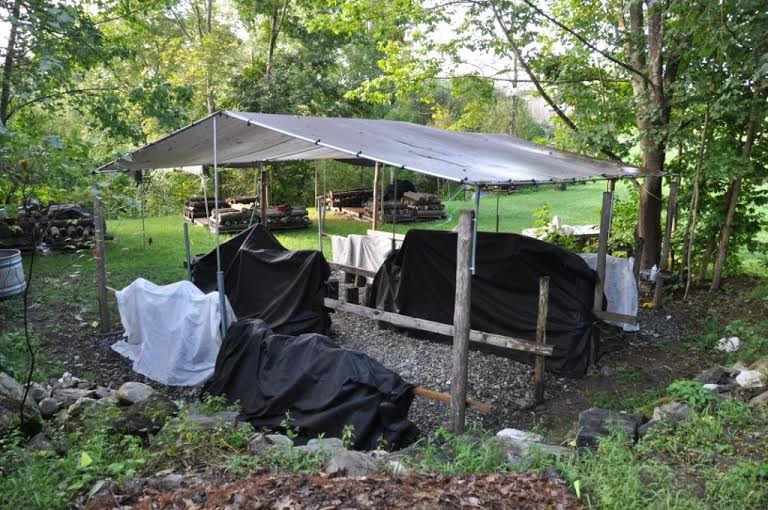
PEST PROTECTION
“Another use of ag cloth worth mentioning is when newly inoculated logs are in a tight crib stack during the spawn run. Certain log species, like Bitternut Hickory, are particularly vulnerable to boring insects, primarily long-horned beetles, which bore into the logs. Ag cloth draped over the crib stack can discourage the adults from laying eggs into the logs in the first place.
Ag cloth also can help to keep pests off of developing mushrooms, especially if tucked in tightly. Some mammals such as red squirrels can develop a taste for shiitake and ag cloth is an effective tool to keep them off. All covering... especially ag cloth... seems also to help keep slugs at bay.”
- Steve Sierigk, Hawk Meadow Farm
“The purpose of the Agribon is too keep the humidity consistent during pinning and fruiting, and it keeps out pests. I just drape Agribon right over the logs and it doesn’t really interfere too much with growth. Sometimes I’ll place a rock or old log on the cloth and pull it away from the logs. That keeps the cloth close to the ground and off any fruiting mushrooms. Agribon keeps my shiitakes safe from nearly all pest damage, except slugs.
A few weeks ago I was looking for some advice on what turned out to be a pleasing fungus beetle attack. The infestation that I got had essentially wiped out 25 percent to 30 percent of my crop one week. The solution was ag cloth on the ground around the a-frames and then we covered the logs at all times with another type of ag cloth, called Agribon (row cover). That stopped the beetles to virtually no attack.
However, a few manage to get in every now and then but they don’t cause nearly the extent of damage as they were on the uncovered logs. This week I haven’t seen one yet. The ag cloth also keeps the thrips to a near minimum. In the end, a constant covering of ag cloth results in nearly perfect mushrooms.”
-Matt Anderson, Tyrrel Mushroom Farm
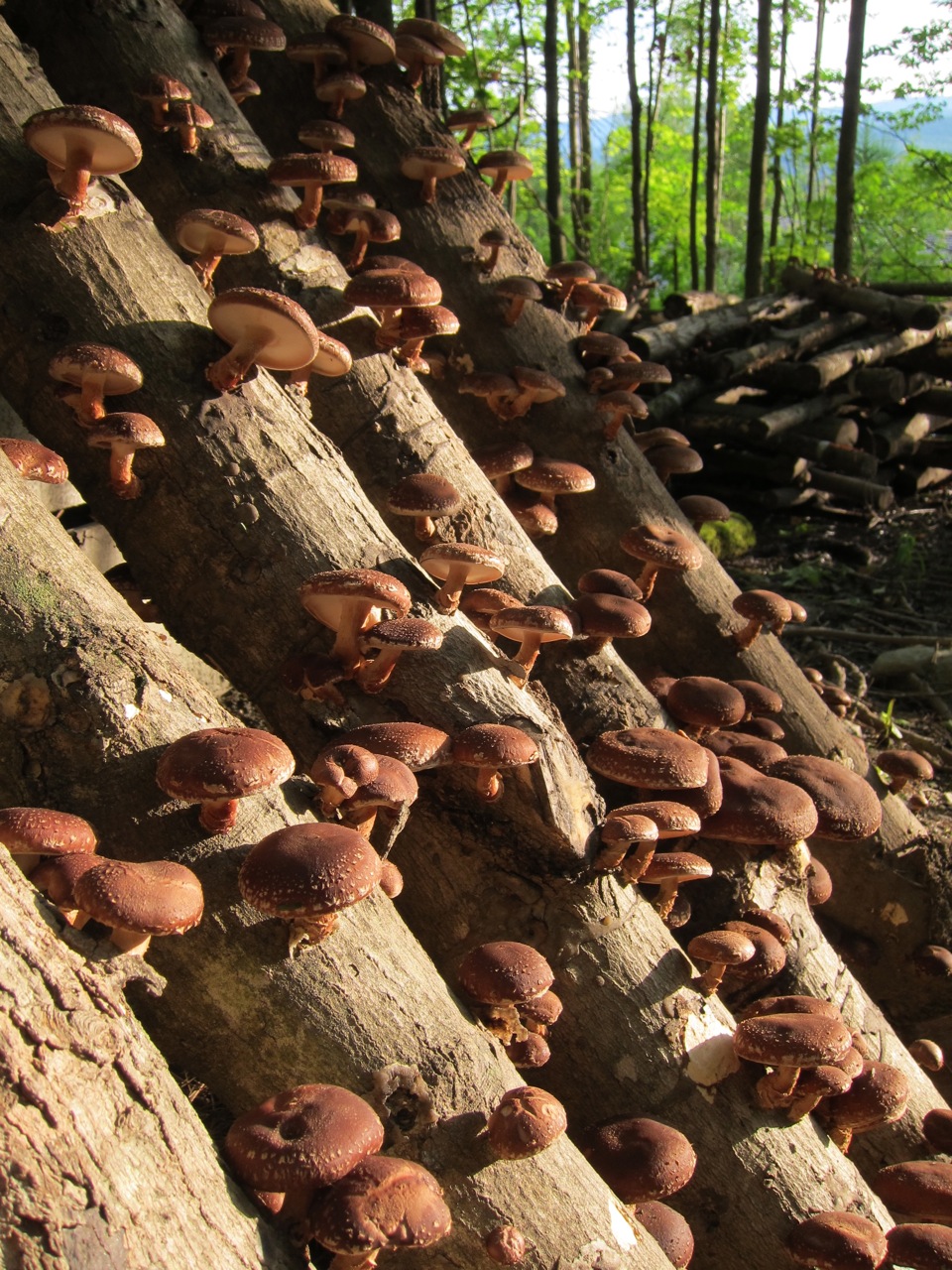
EXPERT TIPS: What yields to expect and how to improve yields
“As far as expected yields ... I think that it is somewhat predictable but has so much to do with many factors; inoculation, selection of good bolts and what tree species are used. A bolt does not always equate to a given amount of mushrooms. For in- stance my bitternut hickory logs give per- haps 30% to 50% of my oak logs and are a management dilemma (the timing of their production spreads out over a few weeks rather than a discrete, quicker time). I have some nice-looking red oak logs that have produced little as they were so slow-growing that their sapwood layer is pitiful! I am really finding that the biggest factor in production is really nice bolts ... but oftentimes we are just working with material that we have at hand. Saying this however you can probably expect one-third to one-half pound per bolt per forcing ... you may get more or less. I have had great logs yield 2 or more per flush ... and I have also had logs that produced little. If forcing 100 logs, 30 to 35 pounds each week is very achievable.
This is one reason I will go out of my way to acquire superior material ... that is since we put so much work into management. But learning what is great material is perhaps part of the necessary learning curve. Also the reality of balancing what bolts we can easily get is part of the whole idea of this as management of our woodlots if we have them.”
-Steve Sierigk, Hawk Meadow Farm
EXPERT OPINION: Copper Wire
“Our first forcing area we actually went as far a putting up copper wire encircling the area around the forced logs ... but I have watched slugs cross over it and from what I have read you would need about a 2-inch width of copper for a slug barrier, impractical for most of us. “
-Steve Sierigk, Hawk Meadow Farm
EXPERT TIPS: Pleasing Fungus Beetle
“Pleasing fungus beetles are rampant in the Hudson Valley. As soon as they realize that you grow mushrooms they move in, and they move in with a vengeance. The solution is to cover your logs while they are fruiting with an agricultural cloth. We use Agribon. Don’t allow any access at all. Agribon is a product that has several advantages for growing shiitakes anyway. It prevents the pins and eventually the mushrooms from drying out. A lot of farmers use it.”
-Matt Anderson, Wood Advisory Services, Inc.
“Chipmunks are a pest in the fall for us and can take a whole bunch of shiitake pins in a few days. They are stocking up, we presume? We see little teeth marks on the logs where the pins were. We’ve also seen teeth marks up under the caps where chipmunks or mice have eaten their favorite parts. Harvest what you think is a perfect shiitake, but no, the critter got there first!”
- Steve and Julie Rockcastle, Green Heron Growers
Common Mushrooms Pests and Concerns
Slug Damage
Slugs cause more damage to shiitake crops than any other pest. They are more common during cool, moist weather. There are many alleged remedies for slugs on Shiitake logs, but there is little agreement about which is best. Below, Northeast growers share their secrets:
- “I provide lots of toad habitat which I really believe can be good allies with slugs. Toads get to become recognized company (live up to 40 years) as they often keep to the same hangouts and you can start to tell individual toads apart. They do eat slugs ... although it would take a good-sized one to eat those big slugs.”
-Steve Sierigk, Hawk Meadow Farm
- “I would go out every night “slugging” with a flashlight and a skewer. Over time there was much less damage.”
-Sal LaFemina
- “I rake under the ferns and leaf/needle litter to locate where they are hiding/resting during the day. Then I introduce my chickens to them. Slugs are a great chicken delicacy, it seems. After 2 to 3 days the problem is back to being manageable.“
-Carol
- “We installed angular gravel in the fruiting area, which helps keep the area well drained for the moisture loving slug. We also use wood ash/charcoal, a by-product from our outside furnace, and Sluggo around the outside of the structure.”
-Bill Stack, Cobb Hill Farm
- “I’ve built a few simple gravel beds, framing them out with old lumber and filling with gravel (the sharper the better). It seems to be working quite well”
-Steve Gabriel, Wellspring Forest Farm, Mecklenburg NY
- “When picking shiitakes, slug checking is just a part of the operation. We do specific slug checks when the shiitakes are developing morning and night. Sometimes this is just a quick 5-minute perusal but certainly after a rain it is more. We feel like it is worth it as otherwise we would lose perhaps 4 to 5 pounds of shiitakes each week to slugs.”
-Steve Sierigk, Hawk Meadow Farm
Pleasing Fungus Beetle
The pleasing fungus beetle is about an eighth inch long with a hard red-brown body. Pleasing fungus beetles feed on the fruiting bodies of fungi. These pests can seriously disrupt a shiitake operation. If they are a problem in your area, we recommend covering fruiting logs with agriculture cloth (such as Agribon). See sidebar for more information.
Squirrels and Chipmunks
If you notice that sections of your mushrooms have been eaten, squirrels may be the culprit. Growers have noticed that some squirrels eat the mushrooms while others simply break them off the log and nibble on them. Possible solutions are to cover fruiting logs with agricultural cloth, allow dogs to roam the laying yard, or trap and remove the offending squirrels.

